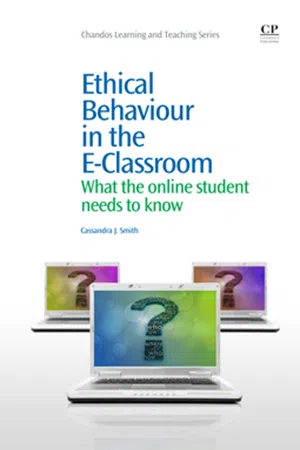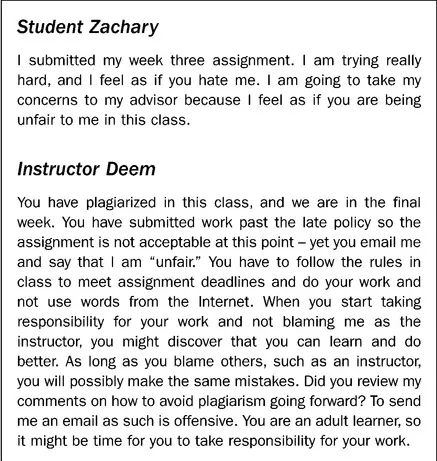![]()
1
Assessing behaviour
Abstract:
Distance learning is global. Characteristics of the online learner are constantly evolving, from young adults graduating from high school to older adults, after working for 20 years, embarking on a degree to achieve a goal that never was relinquished despite life circumstances. With the different types of students, learning levels, ethical backgrounds, and technical skills, the protocols and academic methods in the electronic classroom must be defined. These include, but are not limited to, transformational language, critical thinking, multicultural education, conflict management, collaborative learning, and work integrity, which are all included in ethical principles. The definitions of ethics and associated terms are discussed. Students are shown what “good behaviour” means and how “moral reasoning” impacts classroom behavior, and are also introduced to what it means to be an autonomous learner in the online classroom, adhering to codes of ethics. The concept of self-directed learning is explored for online students planning, carrying out, and evaluating their own learning experiences. Students encounter real-life dialogue in the electronic classroom and will have the opportunity to respond with their opinions to the student cases by answering discussion questions and participating in activities. The chapter concludes with information about codes of ethics.
Key words
ethics
code of ethics
self-directed learning
Ethics definition
What are ethics? Ethics are defined as the study of the rules of conduct. The word is sometimes used to refer to a set of rules, principles, or ways of thinking that guides behaviour. Ethics are a set of values that you adhere to with regard to determining right from wrong. Ethics indicate the practice of right action and the greater good. In essence, ethics are a set of principles for how you live your life. Ethics include good human conduct or behaviour.
What does “good behaviour” mean?
Good behaviour is doing what is considered morally correct in the present protocol of the situation. Morals are the rules of conduct and ideas based on right or wrong. In higher education, following the school’s rules is good, moral behaviour. Good behaviour is conforming to acceptable standards and rules. This could mean doing your class work and not presenting others’ work as your own, or not having someone do the work for you when you are the student enrolled in the online class. In the community, good ethical behaviour includes following the laws of society and conforming to societal order. For some people, ethical behaviour is taught in childhood and gradually becomes innate when making choices. Most people learn right and wrong in their homes during their childhood years and from their environment. For example, you or a childhood friend might have known as a child that telling a lie to parents goes with punishment. You or that person might recall a childhood story about how the punishment was memorable for telling that particular lie. Thus, the process of ethical behaviour evolves into adulthood; good then becomes the opposite of bad or poor behaviour because you, or that friend, understand as an adult that poor choices have repercussions.
If you decide to live by certain standards, known as values, that you have set for yourself as you develop, ethical choices are not difficult because you are comfortable with your decisions and want to meet your goals honestly as adult learners. Your moral reasoning, the thinking process of deciding on what is right or wrong and identifying the dilemma clearly with regard to situations and daily interactions, does not require a long thought process. You innately know what works for you and what type of work ethic you want to contribute to your own success.
Review student case Zachary in Figure 1.1 and reflect on the student’s moral reasoning, his work ethic, and any possible experiences or instructor’s comments that might have influenced this student’s patterns of behaviour.
Figure 1.1 Student case Zachary
Moral reasoning can occur when making ethical decisions. It should consist of stating the facts about the issue and reviewing if there is a problem to start with, as you decide on what is best for you in any given scenario. For good or bad, is there a problem with the student’s writing in Figure 1.1? To personalize moral reasoning, the student in Figure 1.1, Zachary, should ask, “Is there an issue with my writing?” as opposed to assuming the victim’s role in the scenario. What can I do to improve, even if I question a mistake has been made? What good can come from this learning scenario? What is taking priority over the decision? Is it my pride, beliefs, disruptive behaviour, or is good prevailing? These are questions that can be posed in the moral reasoning stages when making decisions and exhibiting actions in the online classroom.
If you were to assess this issue, you might not have placed yourself in this position from the start to apply moral reasoning. Sometimes it is visceral for people to make ethical and moral decisions. Other times, making good choices is difficult and poor choices are more appealing. For example, perhaps a child did not learn the importance of avoiding telling lies to parents and/or teachers. Or, perhaps the child did learn but elected to continue with unethical behaviour. Suppose what appears as good behaviour to one person is, in fact, poor behaviour to others, especially when a child becomes an adult. A war then starts to break out about right or wrong, ethical or unethical, good or poor behaviour.
Ethics and e-classes
What does waging the war of right or wrong and ethical decisions have to do with distance education courses? As the distance education student in college, you are expected to follow the rules set by the school. The rules could consist of meeting assignment deadlines, interacting with your peers and instructors in a courteous manner, and being responsible for the integrity of your work. Ethical decisions online could consist of you as the student disciplining yourself with regard to time management so that you can submit your original work and not be placed in situations where time has influenced your ethical principles. As a general rule, if you are the student enrolled in the course, it is your responsibility to adhere to ethical standards.
When students seek ways to learn and take responsibility for their learning, they are being self-directed learners. “Self-directed learning is a process of learning in which people take the primary initiative for planning, carrying out, and evaluating their own learning experiences” (Merriam et al., 2007).1 When students return to school, particularly online, after years of being out of school or as a result of challenges, they are usually ready to commit to being a self-directed learner. Adults have several reasons for why they are in school, have returned to school, and are ready to commit to the journey of obtaining a college degree. Some reasons include divorce, the need for job growth, and a personal goal that was never realized of obtaining a degree. It seems natural for the adult learner to be self-directed, even with the struggles of reaching the point of being self-directed that some students might encounter. Students eventually start to realize that the amount of effort put into their work and commitment will catapult them into being self-directed and ultimately build confidence to meet educational goals. Review carefully what it means to be a self-directed learner.
Planning
Learning requires planning. For adult learners, planning systematically what they want to learn, where they will pursue their educational goals, and when is a good time in their lives to learn, requires progressive steps and is linear in nature. The adult learner is usually one-dimensional about the idea of being in college and has planned accordingly, although he or she might not realize everything that being in school encompasses. When adult learners return to school, timing is usually a major concern. For self-directed adult learners, this could be attending college immediately after high school. For other self-directed adult learners, this could be attending college after 30 years of being in the workforce. Planning to return to school and identifying optimal times to complete class work requires self-directed planning.
Carrying out
Adult learners can become self-directed by carrying out or seeking ways to hone skills. Participating in online tutorials to enhance writing and reading skills is one way adults can carry out self-directed learning. Reviewing the resources available to aid in learning that the school has is another way to carry out self-directed learning. Learning how to effectively navigate computers and word processors by participating in training can help advance computer proficiency for adult learners. Carrying out becomes a way to learn additional skills that the adult student has assessed regarding areas of personal improvement.
Evaluating
It takes discipline to self-monitor, self-manage, and self-motivate. Self-monitoring ...

